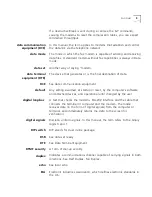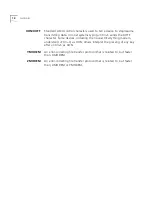
6
G
LOSSARY
EIA-23
A technical specification published by the Electronic Industries
Association that establishes mechanical and electrical interface
requirements between computers, terminals, modems, an
communication lines. EIA-232 was formerly known as RS-232.
equalisation
A compensation circuit designed into modems to counteract certain
distortions introduced by the telephone channel. Two types are used:
fixed (compromise) equalisers and those that adapt to channel
conditions. 3Com high speed modems use adaptive equalisation.
error control
Various techniques which check the reliability of characters (parity) or
blocks of data. V.42, MNP and HST error control protocols use error
detection (CRC) and retransmission of errored frames (ARQ).
expansion bus
A series of slots inside a computer that allow for adding feature cards.
facsimile (fax)
A method for transmitting the image on a printed page from one point
to another.
fax mode
The mode in which the fax modem is capable of sending and receiving
files in a facsimile format.
Flash memory
A form of memory that can be electrically erased and reprogrammed
without the need to remove it from the circuit board.
flow control
A mechanism that compensates for differences in the flow of data
input to and output from a modem or other device.
fram
A data communications term for a block of data with header and
trailer information attached. The added information usually includes a
frame number, block size data, error-check codes, and Start/En
indicators.
file transfer protocol
(FTP)
A TCP/IP application that allows users of an internet to send (put) and
receive (get) files.
FTP
See file transfer protocol.
full duplex
Signal flow in both directions at the same time. In microcomputer
communications, may refer to the suppression of the online Local Echo.
half duplex
Signal flow in both directions, but only one way at a time. In
microcomputer communications, may refer to activation of the online
Local Echo, which causes the modem to send a copy of the transmitted
data to the screen of the sending computer.
Summary of Contents for Courier
Page 12: ......
Page 28: ...1 14 CHAPTER 1 CONNECTING TO YOUR ISP ...
Page 36: ...3 4 CHAPTER 3 UPGRADING YOUR MODEM ...
Page 58: ...6 6 CHAPTER 6 WORKING WITH MEMORY ...
Page 64: ...8 4 CHAPTER 8 CONTROLLING EIA 232 SIGNALING ...
Page 72: ...9 8 CHAPTER 9 ACCESSING AND CONFIGURING THE COURIER V EVERYTHING MODEM REMOTELY ...
Page 80: ...10 8 CHAPTER 10 CONTROLLING DATA RATES ...
Page 96: ...12 6 CHAPTER 12 FLOW CONTROL ...
Page 108: ...13 12 CHAPTER 13 HANDSHAKING ERROR CONTROL DATA COMPRESSION AND THROUGHPUT ...
Page 112: ...14 4 CHAPTER 14 DISPLAYING QUERYING AND HELP SCREENS ...
Page 122: ...15 10 CHAPTER 15 TESTING THE CONNECTION ...
Page 142: ...17 8 CHAPTER 17 TROUBLESHOOTING ...
Page 156: ...A 14 APPENDIX A S REGISTERS ...
Page 172: ...B 16 APPENDIX B ALPHABETIC COMMAND SUMMARY ...
Page 178: ...C 6 APPENDIX C FLOW CONTROL TEMPLATE ...
Page 186: ...E 4 APPENDIX E V 25 BIS REFERENCE ...









































